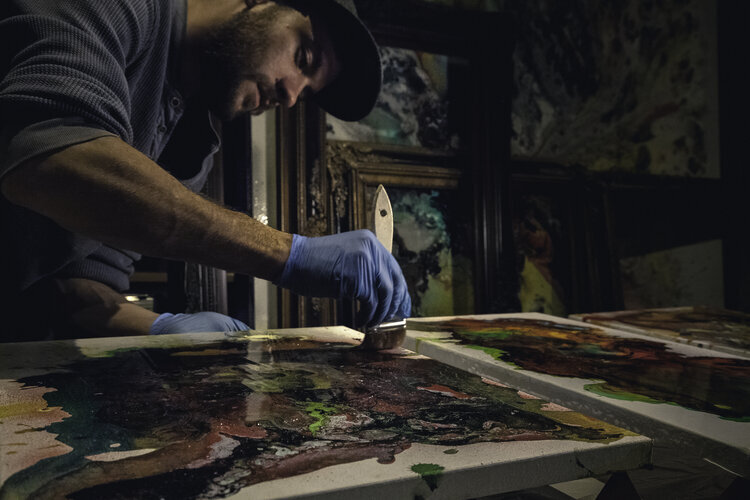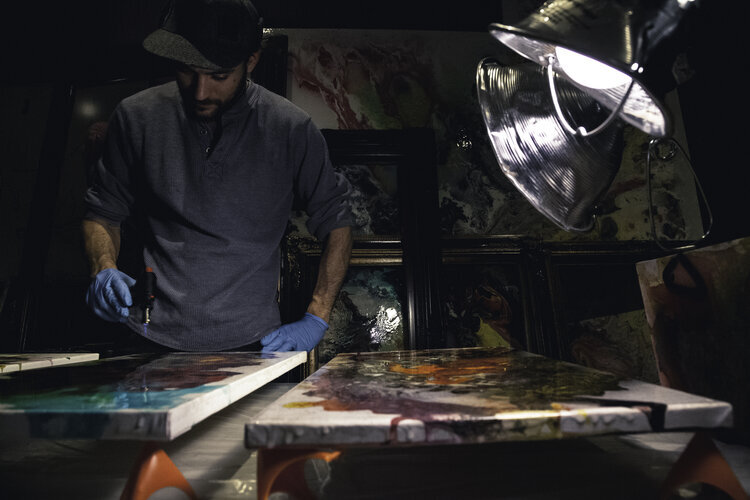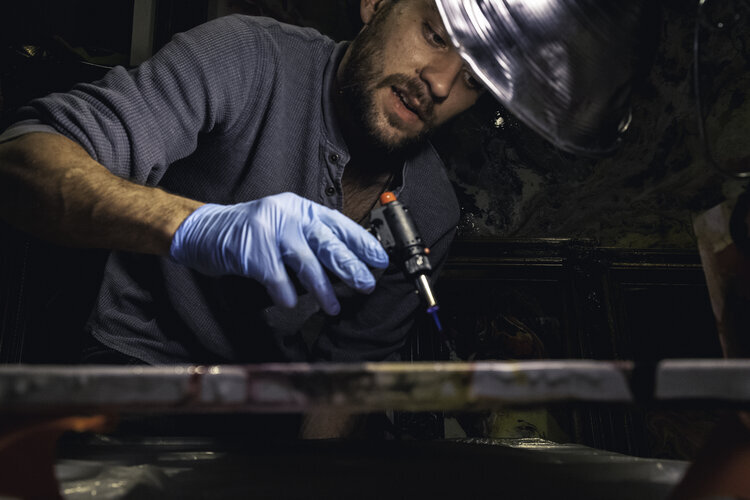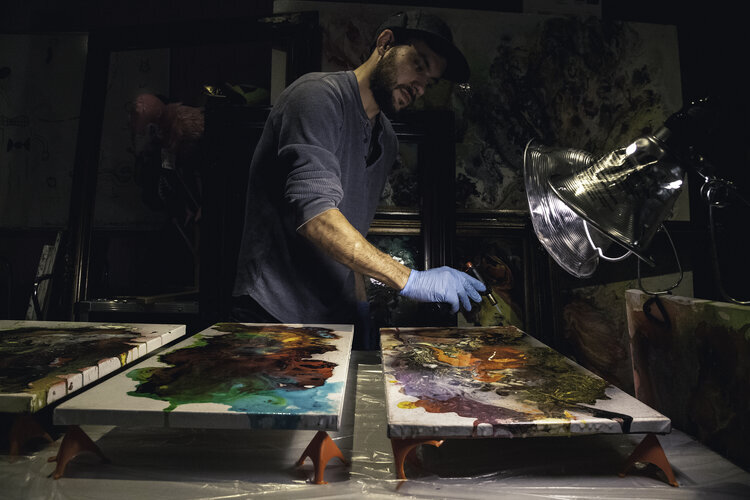The Psychedelic Abstract
Sitting with the Medicine of Alex Carlbon
by Nils I. Palsson
There is a close and intricate relationship between medicine and art.
Medicine comes from the Latin mederi, meaning “to heal, cure,” and originally “to know the best course for” — from the root med- “to measure, consider, advise.”
Art comes from the Latin artem, meaning “skill or craft” — from the root ar- “to fit, join together,” as in the word arm.
If medicine is the cure, then art is the skill — the arm — that creates works that allow us to glimpse this best course forward: the visions, the sounds, the tastes and feelings and thought-forms that elevate us and heal us and move us forward on this journey of consciousness.
Alex Carlbon is a 22-year-old artist from New Jersey, who uses color and shape to create free-associative paintings. Alex is a friend — he is Tribe — and I’ve had his art, his medicine, in my home for a number of years. His pieces have been enjoyed by many visitors, and I’ve appreciated them in private as well, but I’ve never until now written about his work.
Recently, en route from his current home in Auburn, CA, to San Francisco International Airport (headed back East to visit family), Alex transferred some of his new kaleidoscopic artwork videos onto my computer. He also left a few new paintings with me — a series of strongly textured and emotively colored canvases from what might be called a tormented time in this young artist’s life — all of which has occasioned this written reflection.
In the course of this review, I wish to illustrate how art is like medicine — and how Carlbon’s art, specifically, is something like psychedelic medicine (psychedelic, of course, simply meaning “mind-changing,” from psyche- “mind” and delta- “change”). Just as there are medical ingredients in our collective pharmacopoeia which boast a certain ability to open the range of thought patterns and vibrations accessible to us, so can certain works of art. The trick is — and this is really true for those other medicines, as well — one really must create time and space to sit with the work, one must truly do ceremony with it, in order to “get the medicine.”
Carrying the Medicine
Hoping to complete this piece before the Equinox, I carried four of Alex’s paintings with me on a journey from Lake County to the San Francisco Bay Area, thinking I might have some time to “take the medicine” during that busy weekend. But that’s my point exactly: I didn’t just need to look at some images and pound out a quick review: This was medicine I was working with here. These paintings, which took days to create, which contained within them veritable universes, called for ceremony. Like any medicine, art only works if you take it in, and I knew passing glance wouldn’t do the trick. These paintings had sat in the cornier of my living room for weeks, like sacred mushrooms in a baggie on a dusty bookshelf, and now they had come with me on this sacred trip — in my proverbial medicine pouch, blessing the journey, being blessed by the journey — but never able to receive the attention, the deep viewing, that they called for.
I had only a few moments to appreciate the artwork on this trip, one night while visiting my hometown of Pacifica, occasioned by my mother asking about the stack of paintings leaning against the wall in my childhood bedroom. I brought them into the light. We admired them, and she inquired if they were for sale. There was vacant space in her guest bathroom, with exposed screws on the wall needing to be concealed. We hung them, one by one — but, on second thought, the paintings’ hues weren’t quite right for her. She wondered, would he be willing to produce something to match the colors of her new shower curtain?
Certain artwork — transformative artwork, psychedelic artwork — begs to be seen by many. Having the work of these artists purchased represents something of a paradox: The artist receives support and compensation for work produced, while the work itself may threaten to disappear from consciousness entirely. The work may be placed somewhere it can be seen and regarded, where its medicine will be accessible; and it may just as easily end up in a forsaken guest bathroom or, worse yet, in the basement of a collector or hoarder. I promised to ask Alex if he’s be open to a commission for my mom’s bathroom, and I packed the paintings away for the trip back to Lake County.
It hurts when good art is unacknowledged, but even I am guilty of this. To wit: Carlbon’s sacred offerings sat for weeks in an neglected corner of my home floor before I created the space to properly regard them. It wasn’t until the day after completing a major project of my own that I was really able to set these pieces up in a viable living-room gallery and properly sit with them. After the Equinox. And when I did — when I finally cleared the space and took the medicine — my suspicions were confirmed:
The universe is contained within these works of art.
Taking the Medicine
The first thing I want to do when I look at one of Alex’s paintings is touch it, or at least get closer — tilt my head, alter my vantage — to better appreciate and understand its texture. Mostly on canvass (but one on particle board), the abstract tableaux you see are comprised of multiple layers of color-bursting oil paints, swirling together as if still in a liquid state, to form countless shifting and ephemeral apparitions that seem to jump from the surface before you, inviting you to explore the multi-dimensional worlds contained therein. Here a yellow, there a pink. Here it appears almost indented, there — is that wax? Every inch keeps you guessing, interpreting, connecting, and looking deeper still. Is that a ghost? A fist splashing through water? A kingdom, a battle scene, lovers, a mountain, a church? To what heights am I being taken?
While Carlbon’s colors qualify as both bright and vivid, there is also a certain darkness to this series of paintings — just as there is a darkness to our collective psyche, and to the Universe itself. Portions of the canvass are illuminated, often quite intensely, with colorful paint. But with the blackness around the edges and emanating from some of the exposed forms, one gets the impression that our setting is somewhere deep within and yet also perhaps also very far out, that we’re looking into some kind of abyss. There is much to learn from looking into these paintings — but it may also be scary to go there. When we look into these mirrors, we’re liable to see any and all dimensions of ourselves, including, perhaps, those shadowy parts we aren’t quite ready to see.
We can follow the tracks of the paint, as they flow off the canvass into other realms. We can climb across the splashes and mounds of color, piled one over the other, as we wonder how they got there and which came first. Indeed, it appears as if something was revealed on the canvass, rather than added to it. In analyzing the paint, which seems to bubble forth from the roiling sea below, one gets the impression that some force, perhaps not altogether conscious, guided the artist to shape, to uncover, the painting.
“The art I create represents the sacred geometry, the divine connection inherent in all of creation,” Carlbon says, beginning to articulate the meaning behind his work. “The reality we see is just one layer of awareness. There are realities above and below our current level of understanding. These connections are all around us, all day, everywhere.”
There is a veritable symphony here, expressing and pulsating with an underlying oneness throughout an infinity of seemingly different forms. This may be the essential psychedelic teaching — and it is one revealed and felt through Carlbon’s art. While the paintings are clearly abstract, the abundance of swirls and lines, sleek forms and shapes and contrasting colors make it easy to mythologize, to anthropomorphize, to project ourselves into. We’re looking at an abstract painting, but it could just as easily be a close up of a network of neural cells, or a distant nebula. It could be a biography. We could very easily be looking at nature itself.
“I see these old faces in the trees at night, in the clouds and in the carpet, in the water and in my paintings,” Carlbon continues. “Everything I create is to share this vision… inspiring the viewer to make their own connections and freely associate with the shapes and colors of the art, and allowing these connection’s to alter the viewer’s perception.”
In a fractal Universe — which this most arguably is— the whole is represented in each part. Thus, in such a Universe, any part may be taken to microcosmically represent the whole. Carlbon’s art goes to work within us, to effect an alchemical act that is not easy to describe. The paintings’ abstract visages, at once jarringly chaotic and elegantly beautiful, somehow remind us of this complex, fractal nature of reality itself. We get the sense that we are looking somehow into a microscope, a telescope, a mirror. And like good medicine — if we take the time to sit with it — it advises us on the best course forward. The art evokes, educes, the viewer’s truth — and through it, we are healed.
We can’t always be looking at the work of art, just as we can’t always be taking the medicine. But if you can clear some space to do ceremony with these paintings — if you really clear some space to look at them — it can be quite a trip. Dreams, fears, desires, memories, songs, ecstatic visions — look within, and there is no telling what of yourself you will see.



